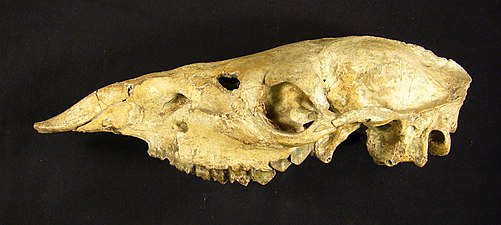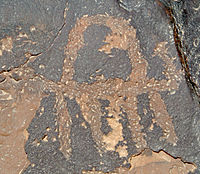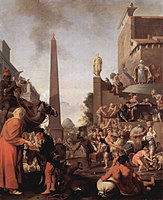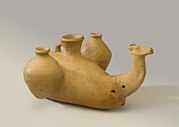Camel
| Camel Temporal range:
| |
|---|---|

| |
| Dromedary (Camelus dromedarius) | |

| |
| Bactrian camel (Camelus bactrianus) | |
| Scientific classification | |
| Domain: | Eukaryota |
| Kingdom: | Animalia |
| Phylum: | Chordata |
| Class: | Mammalia |
| Order: | Artiodactyla |
| Family: | Camelidae |
| Tribe: | Camelini |
| Genus: | Camelus Linnaeus,1758 |
| Type species | |
| Camelus dromedarius[6] Linnaeus, 1758
| |
| Species | |
| |

| |
| Distribution of camels worldwide | |
| Synonyms | |
Acamel(fromLatin:camelusandGreek:κάμηλος(kamēlos) fromAncient Semitic:gāmāl[7][8]) is aneven-toed ungulatein thegenusCamelusthat bears distinctive fatty deposits known as "humps" on its back. Camels have long beendomesticatedand, aslivestock,they provide food (camel milkand meat) and textiles (fiber and felt fromcamel hair). Camels areworking animalsespecially suited to their desert habitat and are a vital means of transport for passengers and cargo. There are three survivingspeciesof camel. The one-humpeddromedarymakes up 94% of the world's camel population, and the two-humpedBactrian camelmakes up 6%. Thewild Bactrian camelis a distinct species that is not ancestral to the domestic Bactrian camel, and is nowcritically endangered,with fewer than 1,000 individuals.
The wordcamelis also used informally in a wider sense, where the more correct term is "camelid", to include all seven species of the familyCamelidae:the true camels (the above three species), along with the "New World" camelids: thellama,thealpaca,theguanaco,and thevicuña,which belong to the separate tribeLamini.[9]Camelids originated in North America during theEocene,with the ancestor of modern camels,Paracamelus,migrating across theBering land bridgeinto Asia during the lateMiocene,around 6 million years ago.
Taxonomy
Extant species
Three species areextant:[10][11]
| Common name | Scientific name and subspecies | Range | Size and ecology | IUCN status and estimated population |
|---|---|---|---|---|
| Bactrian camel | Camelus bactrianus Linnaeus, 1758 |
Domesticated;Central Asia,including the historical region ofBactria.
|
Size: Habitat: Diet: |
|
| Dromedary/ Arabian camel | Camelus dromedarius Linnaeus, 1758 |
Domesticated; theMiddle East,Sahara Desert,andSouth Asia;introduced toAustralia
|
Size: Habitat: Diet: |
|
| Wild Bactrian camel | Camelus ferus Przewalski, 1878 |
Remote areas ofnorthwest ChinaandMongolia
|
Size: Habitat: Diet: |
CR
|
Biology
The averagelife expectancyof a camel is 40 to 50 years.[12]A full-grown adult dromedary camel stands 1.85 m (6 ft 1 in) at the shoulder and 2.15 m (7 ft 1 in) at the hump.[13]Bactrian camels can be a foot taller. Camels can run at up to 65 km/h (40 mph) in short bursts and sustain speeds of up to 40 km/h (25 mph).[14]Bactrian camels weigh 300 to 1,000 kg (660 to 2,200 lb) and dromedaries 300 to 600 kg (660 to 1,320 lb). The widening toes on a camel'shoofprovide supplemental grip for varying soil sediments.[15]
The male dromedary camel has an organ called adullain his throat, a large, inflatable sac that he extrudes from his mouth when inrutto assert dominance and attract females. It resembles a long, swollen, pink tongue hanging out of the side of the camel's mouth.[16]Camels mate by having both male and female sitting on the ground, with the male mounting from behind.[17]The male usuallyejaculatesthree or four times within a single mating session.[18]Camelids are the only ungulates to mate in a sitting position.[19]
Ecological and behavioral adaptations
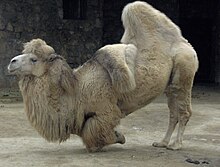
Camels do not directly store water in their humps; they are reservoirs of fatty tissue. When this tissue is metabolized, it yields a greater mass of water than that of the fat processed. Thisfat metabolization,while releasing energy, causes water to evaporate from the lungs duringrespiration(as oxygen is required for the metabolic process): overall, there is a net decrease in water.[20][21]
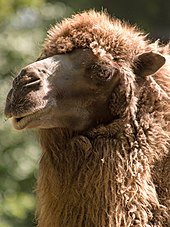

Camels have a series of physiological adaptations that allow them to withstand long periods of time without any external source of water.[23]The dromedary camel can drink as seldom as once every 10 days even under very hot conditions, and can lose up to 30% of its body mass due to dehydration.[24]Unlike other mammals, camels'red blood cellsare oval rather than circular in shape. This facilitates the flow of red blood cells during dehydration[25]and makes them better at withstanding highosmoticvariation without rupturing when drinking large amounts of water: a 600 kg (1,300 lb) camel can drink 200 L (53 US gal) of water in three minutes.[26][27][failed verification]
Camels are able to withstand changes inbody temperatureand water consumption that would kill most other mammals. Their temperature ranges from 34 °C (93 °F) at dawn and steadily increases to 40 °C (104 °F) by sunset, before they cool off at night again.[23]In general, to compare between camels and the other livestock, camels lose only 1.3 liters of fluid intake every day while the other livestock lose 20 to 40 liters per day.[28]Maintaining the brain temperature within certain limits is critical for animals; to assist this, camels have arete mirabile,a complex of arteries and veins lying very close to each other which utilizes countercurrent blood flow to cool blood flowing to the brain.[29]Camels rarely sweat, even when ambient temperatures reach 49 °C (120 °F).[30]Any sweat that does occur evaporates at the skin level rather than at the surface of their coat; theheat of vaporizationtherefore comes from body heat rather than ambient heat. Camels can withstand losing 25% of their body weight in water, whereas most other mammals can withstand only about 12–14% dehydration beforecardiac failureresults from circulatory disturbance.[27]
When the camel exhales,water vaporbecomes trapped in theirnostrilsand is reabsorbed into the body as a means to conserve water.[31]Camels eating green herbage can ingest sufficient moisture in milder conditions to maintain their bodies' hydrated state without the need for drinking.[32]

The camel's thick coat insulates it from the intense heat radiated from desert sand; a shorn camel must sweat 50% more to avoid overheating.[33]During the summer the coat becomes lighter in color, reflecting light as well as helping avoid sunburn.[27]The camel's long legs help by keeping its body farther from the ground, which can heat up to 70 °C (158 °F).[34][35]Dromedaries have a pad of thick tissue over thesternumcalled thepedestal.When the animal lies down in a sternal recumbent position, the pedestal raises the body from the hot surface and allows cooling air to pass under the body.[29]
Camels' mouths have a thick leathery lining, allowing them to chew thorny desert plants. Long eyelashes and ear hairs, together with nostrils that can close, form a barrier against sand. If sand gets lodged in their eyes, they can dislodge it using their translucentthird eyelid(also known as the nictitating membrane). The camels' gait and widened feet help them move without sinking into the sand.[34][36]
Thekidneysandintestinesof a camel are very efficient at reabsorbing water. Camels' kidneys have a 1:4cortextomedulla ratio.[37]Thus, the medullary part of a camel's kidney occupies twice as much area as a cow's kidney. Secondly,renal corpuscleshave a smaller diameter, which reduces surface area for filtration. These two major anatomical characteristics enable camels to conserve water and limit the volume of urine in extreme desert conditions.[38]Camel urinecomes out as a thick syrup, and camel faeces are so dry that they do not require drying when used to fuel fires.[39][40][41][42]
The camelimmune systemdiffers from those of other mammals. Normally, the Y-shapedantibodymolecules consist of two heavy (or long) chains along the length of the Y, and two light (or short) chains at each tip of the Y.[43]Camels, in addition to these, also have antibodies made of only two heavy chains, a trait that makes them smaller and more durable.[43]These "heavy-chain-only" antibodies, discovered in 1993, are thought to have developed 50 million years ago, after camelids split from ruminants and pigs.[43]Camels suffer fromsurracaused byTrypanosoma evansiwherever camels are domesticated in the world,[44]: 2 and resultantly camels have evolved trypanolytic antibodies as with many mammals. In the future, nanobody/single-domain antibodytherapy will surpass natural camel antibodies by reaching locations currently unreachable due to natural antibodies' larger size.[45]: 788 Such therapies may also be suitable for other mammals.[45]: 788 Tranet al.2009 provides a newreference testforsurra(T. evansi) of camel.[46]They userecombinantInvariant Surface Glycoprotein 75(rISG75, anInvariant Surface Glycoprotein) andELISA.[46]The Tran test has hightest specificityand appears likely to work just as well forT. evansiin other hosts, and for a pan-Trypanozoontest, which would also be useful forT. b. brucei,T. b. gambiense,T. b. rhodesiense,andT. equiperdum.[46]
Genetics
Thekaryotypesof different camelid species have been studied earlier by many groups,[47][48][49][50][51][52]but no agreement on chromosome nomenclature of camelids has been reached. A 2007 studyflow sortedcamel chromosomes, building on the fact that camels have 37 pairs of chromosomes (2n=74), and found that the karyotype consisted of onemetacentric,three submetacentric, and 32 acrocentric autosomes. TheYis a small metacentric chromosome, while theXis a large metacentric chromosome.[53]

Thehybrid camel,a hybrid between Bactrian and dromedary camels, has one hump, though it has an indentation 4–12 cm (1.6–4.7 in) deep that divides the front from the back. The hybrid is 2.15 m (7 ft 1 in) at the shoulder and 2.32 m (7 ft 7 in) tall at the hump. It weighs an average of 650 kg (1,430 lb) and can carry around 400 to 450 kg (880 to 990 lb), which is more than either the dromedary or Bactrian can.[54]
According to molecular data, the wild Bactrian camel (C. ferus) separated from the domestic Bactrian camel (C. bactrianus) about 1 million years ago.[55][56]New World and Old World camelids diverged about 11 million years ago.[57]In spite of this, these species can hybridize and produce viable offspring.[58]Thecamais a camel-llama hybrid bred by scientists to see how closely related the parent species are.[59]Scientistscollected semenfrom a camel via an artificial vagina and inseminated a llama after stimulating ovulation withgonadotrophininjections.[60]The cama is halfway in size between a camel and a llama and lacks a hump. It has ears intermediate between those of camels and llamas, longer legs than the llama, and partiallycloven hooves.[61][62]Like themule,camas are sterile, despite both parents having the same number of chromosomes.[60]
Evolution
The earliest known camel, calledProtylopus,lived in North America 40 to 50 million years ago (during theEocene).[18]It was about the size of a rabbit and lived in the open woodlands of what is nowSouth Dakota.[63][64]By 35 million years ago, thePoebrotheriumwas the size of a goat and had many more traits similar to camels and llamas.[65][66]The hoofedStenomylus,which walked on the tips of its toes, also existed around this time, and the long-neckedAepycamelusevolved in theMiocene.[67]The split between the tribesCamelini,which contains modern camels andLamini,modernllamas,alpacas,vicuñas,andguanacos,is estimated to have occurred over 16 million years ago.[68]
The ancestor of modern camels,Paracamelus,migrated into Eurasia from North America viaBeringiaduring the late Miocene, between 7.5 and 6.5 million years ago.[69][70][71]During the Pleistocene, around 3 to 1 million years ago, the North American Camelidae spread to South America as part of theGreat American Interchangevia the newly formedIsthmus of Panama,where they gave rise toguanacosand related animals.[18][63][64]Populations ofParacameluscontinued to exist in the North American Arctic into theEarly Pleistocene.[72][73]This creature is estimated to have stood around nine feet (2.7 metres) tall. The Bactrian camel diverged from the dromedary about 1 million years ago, according to the fossil record.[74]
The last camel native to North America wasCamelops hesternus,which vanished along withhorses,short-faced bears,mammothsandmastodons,ground sloths,sabertooth cats,and many other megafauna as part of theQuaternary extinction event,coinciding with the migration of humans from Asia at the end of the Pleistocene, around 13–11,000 years ago.[75][76]
An extinct giant camel species,Camelus knoblochiroamed Asia during the Late Pleistocene, before becoming extinct around 20,000 years ago.[77]
-
Stenomylusillustration
-
Stenomylusskeleton
-
Poebrotheriumskeleton
-
Procamelusskull
-
Camelops hesternus,the last true camel native to North America
Domestication



Likehorses,camels originated in North America and eventually spread acrossBeringiato Asia. They survived in the Old World, and eventually humans domesticated them and spread them globally. Along with many other megafauna in North America, the original wild camels were wiped out during the spread of the firstindigenous peoples of the Americasfrom Asia into North America, 10 to 12,000 years ago; although fossils have never been associated with definitive evidence of hunting.[75][76]
Most camels surviving today are domesticated.[42][78]Althoughferalpopulations exist inAustralia,India and Kazakhstan, wild camels survive only in thewild Bactrian camelpopulation of theGobi Desert.[12]
History
When humans first domesticated camels is disputed. Dromedaries may have first been domesticated by humans inSomaliaorSouth Arabiasometime during the3rd millennium BC,the Bactrian incentral Asiaaround 2,500 BC,[18][79][80][81]as at Shar-i Sokhta (also known as the Burnt City),Iran.[82]A study from 2016, which genotyped and used world-wide sequencing of modern and ancient mitochondrial DNA (mtDNA), suggested that they were initially domesticated in the southeast Arabian Peninsula,[83]with the Bactrian type later being domesticated around Central Asia.[84]
Martin Heide's 2010 work on the domestication of the camel tentatively concludes that humans had domesticated the Bactrian camel by at least the middle of the third millennium somewhere east of theZagros Mountains,with the practice then moving into Mesopotamia. Heide suggests that mentions of camels "in the patriarchal narratives may refer, at least in some places, to the Bactrian camel", while noting that the camel is not mentioned in relationship toCanaan.[85]Heide and Joris Peters reasserted that conclusion in their 2021 study on the subject.[86]
In 2009–2013, excavations in theTimna Valleyby Lidar Sapir-Hen and Erez Ben-Yosef discovered what may be the earliest domestic camel bones yet found in Israel or even outside theArabian Peninsula,dating to around 930 BC. This garnered considerable media coverage, as it is strong evidence that the stories ofAbraham,Jacob,Esau,andJosephwerewritten after this time.[87][88]
The existence of camels in Mesopotamia—but not in the eastern Mediterranean lands—is not a new idea. The historianRichard Bullietdid not think that the occasional mention of camels in the Bible meant that the domestic camels were common in the Holy Land at that time.[89]The archaeologistWilliam F. Albright,writing even earlier, saw camels in the Bible as ananachronism.[90]
The official report by Sapir-Hen and Ben-Joseph says:
The introduction of the dromedary camel (Camelus dromedarius) as a pack animal to thesouthern Levant... substantially facilitated trade across the vast deserts of Arabia, promoting both economic and social change (e.g., Kohler 1984; Borowski 1998: 112–116; Jasmin 2005). This... has generated extensive discussion regarding the date of the earliest domestic camel in the southern Levant (and beyond) (e.g., Albright 1949: 207; Epstein 1971: 558–584; Bulliet 1975; Zarins 1989; Köhler-Rollefson 1993; Uerpmann and Uerpmann 2002; Jasmin 2005; 2006; Heide 2010; Rosen and Saidel 2010; Grigson 2012). Most scholars today agree that the dromedary was exploited as a pack animal sometime in the earlyIron Age(not before the 12th century [BC])
and concludes:
Current data from copper smelting sites of theAravah Valleyenable us to pinpoint the introduction of domestic camels to the southern Levant more precisely based on stratigraphic contexts associated with an extensive suite ofradiocarbon dates.The data indicate that this event occurred not earlier than the last third of the 10th century [BC] and most probably during this time. The coincidence of this event with a major reorganization of the copper industry of the region—attributed to the results of the campaign of PharaohShoshenq I—raises the possibility that the two were connected, and that camels were introduced as part of the efforts to improve efficiency by facilitating trade.[88]
-
A camel serving as adraft animalinPakistan(2009)
-
A camel in a ceremonial procession, its rider playingkettledrums,Mughal Empire(c. 1840)
-
Joseph Sells GrainbyBartholomeus Breenbergh(1655), showing camel with rider at left
Textiles
Desert tribes and Mongolian nomads use camel hair for tents,yurts,clothing, bedding and accessories. Camels have outer guard hairs and soft inner down, and the fibers may also be sorted by color and age of the animal. The guard hairs can be felted for use as waterproof coats for the herdsmen, while the softer hair is used for premium goods.[91]The fiber can be spun for use in weaving or made into yarns for hand knitting or crochet. Pure camel hair is recorded as being used forwestern garmentsfrom the 17th century onwards, and from the 19th century a mixture of wool and camel hair was used.[92]
Military uses


By at least 1200 BC the first camel saddles had appeared, andBactrian camelscould be ridden. The first saddle was positioned to the back of the camel, and control of the Bactrian camel was exercised by means of a stick. However, between 500 and 100 BC, Bactrian camels came into military use. New saddles, which were inflexible and bent, were put over the humps and divided the rider's weight over the animal. In the seventh century BC the military Arabian saddle evolved, which again improved the saddle design slightly.[93][94]
Military forces have usedcamel cavalriesin wars throughout Africa, the Middle East, and their use continues into the modern-day within theBorder Security Force(BSF) ofIndia.The first documented use of camel cavalries occurred in theBattle of Qarqarin 853 BC.[95][96][97]Armies have also used camels as freight animals instead of horses and mules.[98][99]
TheEast Roman Empireusedauxiliaryforces known asdromedarii,whom the Romans recruited in desert provinces.[100][101]The camels were used mostly in combat because of their ability to scare off horses at close range (horses are afraid of the camels' scent),[19]a quality famously employed by theAchaemenidPersians when fightingLydiain theBattle of Thymbra(547 BC).[54][102][103]
19th and 20th centuries
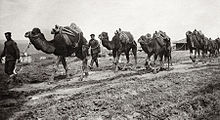
TheUnited States Armyestablished theU.S. Camel Corps,stationed inCalifornia,in the 19th century.[19]One may still see stables at theBenicia ArsenalinBenicia, California,where they nowadays serve as the Benicia Historical Museum.[104]Though the experimental use of camels was seen as a success (John B. Floyd,Secretary of Warin 1858, recommended that funds be allocated towards obtaining a thousand more camels), the outbreak of theAmerican Civil Warin 1861 saw the end of the Camel Corps: Texas became part of the Confederacy, and most of the camels were left to wander away into the desert.[99]
France created améharistecamel corps in 1912 as part of theArmée d'Afriquein the Sahara[105]in order to exercise greater control over the camel-ridingTuaregand Arab insurgents, as previous efforts to defeat them on foot had failed.[106]TheFree French Camel Corpsfought duringWorld War II,and camel-mounted units remained in service until the end of French rule over Algeria in 1962.[107]
In 1916, the British created theImperial Camel Corps.It was originally used to fight theSenussi,but was later used in theSinai and Palestine CampaigninWorld War I.The Imperial Camel Corps comprised infantrymen mounted on camels for movement across desert, though they dismounted at battle sites and fought on foot. After July 1918, the Corps began to become run down, receiving no new reinforcements, and was formally disbanded in 1919.[108]
In World War I, the British Army also created theEgyptian Camel Transport Corps,which consisted of a group of Egyptian camel drivers and their camels. The Corps supported British war operations inSinai,Palestine, and Syria by transporting supplies to the troops.[109][110][111]
TheSomaliland Camel Corpswas created by colonial authorities inBritish Somalilandin 1912; it was disbanded in 1944.[112]
Bactrian camels were used by Romanian forces duringWorld War IIin the Caucasian region.[113]At the same period the Soviet units operating aroundAstrakhanin 1942 adopted local camels as draft animals due to shortage of trucks and horses, and kept them even after moving out of the area. Despite severe losses, some of these camels ended up as far west as toBerlin itself.[114]
TheBikaner Camel CorpsofBritish Indiafought alongside theBritish Indian Armyin World Wars I and II.[115]
TheTropas Nómadas(Nomad Troops) were an auxiliary regiment ofSahrawitribesmen serving in the colonial army in Spanish Sahara (todayWestern Sahara). Operational from the 1930s until the end of the Spanish presence in the territory in 1975, theTropas Nómadaswere equipped with small arms and led by Spanish officers. The unit guarded outposts and sometimes conducted patrols on camelback.[116][117]
21st century competition
The annual King Abdulaziz Camel Festival is held in Saudi Arabia. In addition to camel racing and camel milk tasting, the festival holds a camel "beauty pageant"with prize money of $57m (£40m). In 2018, 12 camels were disqualified from the beauty contest after their owners were found to have injected them withbotox.[118]In a similar incident in 2021, over 40 camels were disqualified.[119]
Food uses
Camel meat and milk are foods that are found in many cuisines, typically inMiddle Eastern,North Africanand someAustralian cuisines.[120][121][122][123]
Dairy
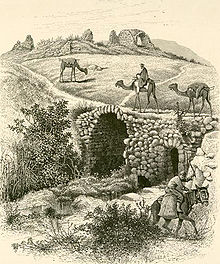
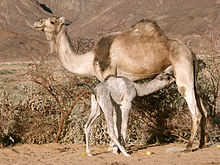
Camel milk is astaple foodof desert nomad tribes and is sometimes considered a meal itself; a nomad can live on only camel milk for almost a month.[19][39][124][125]
Camel milk can readily be made intoyogurt,but can only be made intobutterif it is soured first, churned, and aclarifying agentis then added.[19]Until recently, camel milk could not be made intocamel cheesebecauserennetwas unable to coagulate the milk proteins to allow the collection ofcurds.[126]Developing less wasteful uses of the milk, theFAOcommissioned Professor J.P. Ramet of theÉcole Nationale Supérieure d'Agronomie et des Industries Alimentaires,who was able to produce curdling by the addition ofcalcium phosphateand vegetable rennet in the 1990s.[127]The cheese produced from this process has low levels of cholesterol and is easy to digest, even for the lactose intolerant.[128][129]
Camel milk can also be made intoice cream.[130][131]
Meat
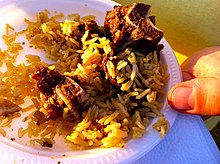

Camels provide food in the form of meat and milk.[132]Approximately 3.3 million camels and camelids are slaughtered each year for meat worldwide.[133]A camel carcass can provide a substantial amount of meat. The male dromedary carcass can weigh 300–400 kg (661–882 lb), while the carcass of a male Bactrian can weigh up to 650 kg (1,433 lb). The carcass of a female dromedary weighs less than the male, ranging between 250 and 350 kg (550 and 770 lb).[18]The brisket, ribs and loin are among the preferred parts, and the hump is considered a delicacy.[134]The hump contains "white and sickly fat", which can be used to make thekhli(preserved meat) of mutton, beef, or camel.[135]On the other hand, camel milk and meat are rich in protein, vitamins, glycogen, and other nutrients making them essential in the diet of many people. From chemical composition to meat quality, the dromedary camel is the preferred breed for meat production. It does well even in arid areas due to its unusual physiological behaviors and characteristics, which include tolerance to extreme temperatures, radiation from the sun, water paucity, rugged landscape and low vegetation.[136]Camel meat is reported to taste like coarse beef, but older camels can prove to be very tough,[13][18]although camel meat becomes tenderer the more it is cooked.[137]
Camel is one of the animals that can be ritually slaughtered and divided into three portions (one for the home, one for extended family/social networks, and one for those who cannot afford to slaughter an animal themselves) for thequrbanofEid al-Adha.[138][139]
TheAbu DhabiOfficers' Club serves a camel burger mixed with beef or lamb fat in order to improve the texture and taste.[140]InKarachi, Pakistan,some restaurants prepareniharifrom camel meat.[141]Specialist camel butchers provide expert cuts, with the hump considered the most popular.[142]
Camel meat has been eaten for centuries. It has been recorded byancient Greekwriters as an available dish at banquets in ancientPersia,usually roasted whole.[143]TheRomanemperorHeliogabalusenjoyed camel's heel.[39]Camel meat is mainly eaten in certain regions, includingEritrea,Somalia,Djibouti,Saudi Arabia,Egypt,Syria,Libya,Sudan,Ethiopia,Kazakhstan,and other arid regions where alternative forms of protein may be limited or where camel meat has had a long cultural history.[18][39][134]Camel blood is also consumable, as is the case among pastoralists in northernKenya,where camel blood is drunk with milk and acts as a key source ofiron,vitamin D,salts and minerals.[18][134][144]
A 2005 report issued jointly by the SaudiMinistry of Healthand the United StatesCenters for Disease Control and Preventiondetails four cases of humanbubonic plagueresulting from the ingestion of raw camel liver.[145]
Camel meat is also occasionally found inAustralian cuisine:for example, a camellasagnais available inAlice Springs.[143][144]Australia has exported camel meat, primarily to theMiddle Eastbut also to Europe and the US, for many years.[146]The meat is very popular amongEast African Australians,such asSomalis,and other Australians have also been buying it. The feral nature of the animals means they produce a different type of meat to farmed camels in other parts of the world,[147]and it is sought after because it is disease-free, and a unique genetic group. Demand is outstripping supply, and governments are being urged not to cull the camels, but redirect the cost of the cull into developing the market. Australia has seven camel dairies, which produce milk, cheese and skincare products in addition to meat.[148]
Religion
Islam
Muslimsconsider camel meathalal(Arabic:حلال,'allowed'). However, according to someIslamic schools of thought,a state of impurity is brought on by the consumption of it. Consequently, these schools hold that Muslims must performwudhu(ablution) before the next time theyprayafter eating camel meat.[149]Also, some Islamic schools of thought consider itharam(Arabic:حرام,'forbidden') for a Muslim to performSalatin places where camels lie, as it is said to be a dwelling place of theShaytan(Arabic:شيطان,'Devil').[149]According toAbu Yusuf(d.798), theurine of camelsmay be used for medical treatment if necessary, but according toAbū Ḥanīfah,the drinking of camel urine is discouraged.[150]
Islamic texts contain several stories featuring camels. In the story of the people ofThamud,the prophetSalihmiraculously brings forth anaqat(Arabic:ناقة,'milch-camel') out of a rock. AfterMuhammadmigrated fromMeccatoMedina(theHijrah), he allowedhis she-camelto roam there; the location where the camel stopped to rest determined the location where he would build his house in Medina.[151]
Judaism
According toJewishtradition, camel meat and milk are notkosher.[152]Camels possess only one of the twokosher criteria;although theychew their cud,they do not havecloven hooves:"But these you shall not eat among those that bring up the cud and those that have a cloven hoof: the camel, because it brings up its cud, but does not have a [completely] cloven hoof; it is unclean for you."[153]
The Palestinian MuslimMakhamara claninYatta,who claim descent from Jews, reportedly avoid eating camel meat, a practice cited as evidence of their Jewish origins.[154][155]
Cultural depictions
What may be the oldest carvings of camels were discovered in 2018 in Saudi Arabia. They were analysed by researchers from several scientific disciplines and, in 2021, were estimated to be 7,000 to 8,000 years old.[156]The dating ofrock artis made difficult by the lack of organic material in the carvings that may be tested, so the researchers attempting to date them tested animal bones found associated with the carvings, assessed erosion patterns, and analysed tool marks in order to determine a correct date for the creation of the sculptures. ThisNeolithicdating would make the carvings significantly older than Stonehenge (5,000 years old) and the Egyptian pyramids at Giza (4,500 years old) and it predates estimates for the domestication of camels.
-
Shadda (cover,detail), Karabagh region, southwest Caucasus, early 19th century
-
Vessel in the form of a recumbent camel with jugs, 250 BC – 224 AD,Brooklyn Museum
-
Maru Ragini(Dhola and Maru Riding on a Camel),c. 1750,Brooklyn Museum
-
The Magi Journeying(Les rois mages en voyage)—James Tissot, c. 1886,Brooklyn Museum
-
How the Camel Got His Hump(FromRudyard Kipling'sJust So Stories)
Distribution and numbers
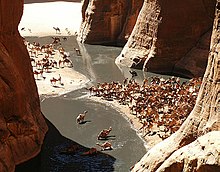
There are approximately 14 million camels alive as of 2010[update],with 90% being dromedaries.[157]Dromedaries alive today aredomesticated animals(mostly living in theHorn of Africa,theSahel,Maghreb,Middle EastandSouth Asia). The Horn region alone has the largest concentration of camels in the world,[22]where the dromedaries constitute animportant part of local nomadic life.They provide nomadic people in Somalia[18]and Ethiopia with milk, food, and transportation.[125][158][159][160]

Over one million dromedary camels are estimated to beferal in Australia,descended from those introduced as a method of transport in the 19th and early 20th centuries.[161]This population is growing about 8% per year;[162]it was estimated at 700,000 in 2008.[144][157][163]Representatives of the Australian government have culled more than 100,000 of the animals in part because the camels use too much of the limited resources needed by sheep farmers.[164]
A small population of introduced camels, dromedaries and Bactrians, wandered throughSouthwestern United Statesafter having been imported in the 19th century as part of theU.S. Camel Corpsexperiment. When the project ended, they were used as draft animals in mines and escaped or were released. Twenty-five U.S. camels were bought and exported to Canada during theCariboo Gold Rush.[99]
The Bactrian camel is, as of 2010[update],reduced to an estimated 1.4 million animals, most of which are domesticated.[42][157][165]TheWild Bactrian camelis the only truly wild (as opposed to feral) camel in the world. It is a distinct species that is not ancestral to the domestic Bactrian camel. The wild camels are critically endangered and number approximately 950, inhabiting the Gobi and Taklamakan Deserts in China and Mongolia.[166]
See also
References
Notes
- ^"Fossilworks: Camelus".fossilworks.org.Archived fromthe originalon 2021-12-12.Retrieved2021-12-17.
- ^Geraads, D.; Barr, W. A.; Reed, D.; Laurin, M.; Alemseged, Z. (2019)."New Remains ofCamelus grattardi(Mammalia, Camelidae) from the Plio-Pleistocene of Ethiopia and the Phylogeny of the Genus "(PDF).Journal of Mammalian Evolution.28(2): 359–370.doi:10.1007/s10914-019-09489-2.ISSN1064-7554.S2CID209331892.Archived(PDF)from the original on 2020-10-03.
- ^Titov, V. V. (2008). "Habitat conditions forCamelus knoblochiand factors in its extinction ".Quaternary International.179(1): 120–125.Bibcode:2008QuInt.179..120T.doi:10.1016/j.quaint.2007.10.022.
- ^Falconer, Hugh (1868).Palæontological Memoirs and Notes of the Late Hugh Falconer: Fauna antiqua sivalensis.R. Hardwicke. p.231.
- ^Martini, P.; Geraads, D. (2019)."Camelus thomasiPomel, 1893 from the Pleistocene type-locality Tighennif (Algeria). Comparisons with modernCamelus".Geodiversitas.40(1): 115–134.doi:10.5252/geodiversitas2018v40a5.
- ^Wilson, D. E.;Reeder, D. M., eds. (2005).Mammal Species of the World: A Taxonomic and Geographic Reference(3rd ed.).Johns Hopkins University Press.ISBN978-0-8018-8221-0.OCLC62265494.
- ^"camel".The New Oxford American Dictionary(2nd ed.). Oxford University Press, Inc. 2005.
- ^Herper, Douglas."camel".Online Etymology Dictionary.Archivedfrom the original on 27 September 2013.Retrieved28 November2012.
- ^Bornstein, Set (2010)."Important ectoparasites of Alpaca (Vicugna pacos)".Acta Veterinaria Scandinavica.52(Suppl 1): S17.doi:10.1186/1751-0147-52-S1-S17.ISSN1751-0147.PMC2994293.
- ^Burger, P. A.; Ciani, E.; Faye, B. (2019-09-18)."Old World camels in a modern world – a balancing act between conservation and genetic improvement".Animal Genetics.50(6): 598–612.doi:10.1111/age.12858.PMC6899786.PMID31532019.
- ^Chuluunbat, B.; Charruau, P.; Silbermayr, K.; Khorloojav, T.; Burger, P. A. (2014)."Genetic diversity and population structure of Mongolian domestic Bactrian camels (Camelus bactrianus)".Anim Genet.45(4): 550–558.doi:10.1111/age.12158.PMC4171754.PMID24749721.
- ^ab"Bactrian Camel: Camelus bactrianus".National Geographic.10 May 2011. Archived fromthe originalon 4 November 2012.Retrieved28 November2012.
- ^ab"The amazing characteristics of the camels".Camello Safari.Archivedfrom the original on 7 November 2012.Retrieved26 November2012.
- ^"How Fast Can Camels Run and How Long Can They Run For?".Big Site of Amazing Facts.17 April 2010.Retrieved29 November2012.
- ^Fayed, R. H. "Adaptation of the Camel to Desert environment." Proceedings of the ESARF 11th Annual Conference. Available at:<http://esarf2[permanent dead link].tripod. com/conf2001proc. htm>,(accessed on November 18, 2010). 2001.
- ^Abu-Zidana, Fikri M.; Eida, Hani O.; Hefnya, Ashraf F.; Bashira, Masoud O.; Branickia, Frank (18 December 2011). "Camel bite injuries in United Arab Emirates: A 6 year prospective study".Injury.43(9): 1617–1620.doi:10.1016/j.injury.2011.10.039.PMID22186231.
The male mature camel has a specialized inflatable diverticulum of the soft palate called the "Dulla". and During rutting the Dulla enlarges on filling with air from the trachea until it hangs out of the mouth of the camel and comes to resemble a pink ball. This occurs in only the one-humped camel. Copious saliva turns to foam covering the mouth as the male gurgles and makes metallic sounds. [6 cites to 5 references omitted]
- ^Two Male Camels Fighting Over One Female.Youtube.com.Archivedfrom the original on 2015-12-19.Retrieved2016-01-08.
- ^abcdefghiMukasa-Mugerwa, E. (1981).The Camel (Camelus Dromedarius): A Bibliographical Review.International Livestock Centre for Africa Monograph. Vol. 5. Ethiopia: International Livestock Centre for Africa. pp. 1, 3, 20–21, 65, 67–68.
- ^abcde"Bactrian & Dromedary Camels".Factsheets.San Diego Zoo Global Library. March 2009. Archived fromthe originalon 22 September 2012.Retrieved4 December2012.
- ^Vann Jones, Kerstin."What secrets lie within the camel's hump?".Sweden:Lund University.Archivedfrom the original on 23 May 2009.Retrieved7 January2008.
- ^Rastogi, S. C. (1971).Essentials Of Animal Physiology.New Age International.pp. 180–181.ISBN9788122412796.
- ^abBernstein, William J. (2009).A Splendid Exchange: How Trade Shaped the World.Grove Press. p. 56.ISBN9780802144164.
- ^abRoberts, Michael Bliss Vaughan (1986).Biology: A Functional Approach.Nelson Thornes.pp. 234–235, 241.ISBN9780174480198.
- ^UNESCO."The Camel from Tradition To Modern Times"(PDF).Archived(PDF)from the original on 2015-11-09.
- ^Eitan, A; Aloni, B; Livne, A (1976). "Unique properties of the camel erythrocyte membraneII. Organization of membrane proteins".Biochimica et Biophysica Acta (BBA) - Biomembranes.426(4): 647–58.doi:10.1016/0005-2736(76)90129-2.PMID816376.
- ^"Dromedary".Hannover Zoo. Archived fromthe originalon 25 October 2005.Retrieved8 January2008.
- ^abcHalpern, E. Anette (1999)."Camel".In Mares; Michael A. (eds.).Deserts.University of Oklahoma Press. pp. 96–97.ISBN9780806131467.Archivedfrom the original on 2016-04-29.
- ^Breulmann, M., Böer, B., Wernery, U., Wernery, R., El Shaer, H., Alhadrami, G.,... Norton, J. (2007). "The Camel From Tradition to Modern Times" (PDF).UNESCODOHA OFFICE.
- ^abInside Nature's Giants.Channel 4 (UK)documentary. Transmitted 30 August 2011
- ^"Arabian (Dromedary) Camel".National Geographic.National Geographic Society.10 May 2011. Archived fromthe originalon 19 November 2012.Retrieved25 November2012.
- ^Lewis, Paul (12 July 1981)."A Pilgrimage To A Mystic's Hermitage In Algeria".The New York Times.Archivedfrom the original on 4 August 2009.Retrieved7 March2009.
- ^"Camels, llamas and alpacas".A manual for primary animal health care worker.FAO Animal Health Manual.FAO Agriculture and Consumer Protection.1994.ISSN1020-5187.Archivedfrom the original on 2008-07-27.
- ^Schmidt-Nielsen, K. (1964).Desert Animals: Physiological Problems of Heat and Water.New York:Oxford University Press(OUP).Cited in"Coat of fur on the camel".Davidson College.Archived fromthe originalon February 25, 2003.
- ^abBronx Zoo."Camel Adaptations".Wildlife Conservation Society.Archived fromthe original(Flash)on 26 June 2012.Retrieved29 November2012.
- ^Rundel, Philip Wilson; Gibson, Arthur C. (30 September 2005). "Adaptations of Mojave Desert Animals".Ecological Communities And Processes in a Mojave Desert Ecosystem: Rock Valley, Nevada.Cambridge University Press(CUP). p. 130.ISBN9780521021418.
- ^Silverstein, Alvin; Silverstein, Virginia B; Silverstein, Virginia; Silverstein Nunn, Laura (2008).Adaptation.Twenty-First Century Books. pp.42–43.ISBN9780822534341.
- ^"Morphometric analysis of heart, kidneys and adrenal glands in dromedary camel calves (PDF Download Available)".ResearchGate.Archivedfrom the original on 2017-03-04.Retrieved2017-03-03.
- ^Rehan S and AS Qureshi, 2006. Microscopic evaluation of the heart, kidneys and adrenal glands of one-humped camel calves (Camelus dromedarius) using semi automated image analysis system. J Camel Pract Res. 13(2): 123
- ^abcdDavidson, Alan; Davidson, Jane (15 October 2006). Jaine, Tom (ed.).The Oxford Companion to Food(2nd ed.). Oxford University Press, US. pp. 68, 129, 266, 762.ISBN978-0192806819.
- ^"Kidneys and Concentrated Urine".Temperature and Water Relations in Dromedary Camels (Camelus dromedarius).Davidson College. Archived fromthe originalon February 25, 2003.
- ^"Fun facts about the Camel".The Jungle Store.Archived fromthe originalon 17 November 2012.Retrieved3 December2012.
- ^abcFedewa, Jennifer L. (2000)."Camelus bactrianus".Animal Diversity Web.University of Michigan Museum of Zoology. Archived fromthe originalon 26 May 2013.Retrieved4 December2012.
- ^abcKoenig, R. (2007). "'Camelized' Antibodies Make Waves ". Veterinary Medicine.Science.318(5855): 1373.doi:10.1126/science.318.5855.1373.PMID18048665.S2CID71028674.
- ^Sazmand, Alireza; Joachim, Anja (2017)."Parasitic diseases of camels in Iran (1931–2017) – a literature review".Parasite.24.EDP Sciences:1–15.doi:10.1051/parasite/2017024.ISSN1776-1042.PMC5479402.PMID28617666.S2CID13783061.Article Number 21.
- ^abMuyldermans, Serge (2013-06-02). "Nanobodies: Natural Single-Domain Antibodies".Annual Review of Biochemistry.82(1).Annual Reviews:775–797.doi:10.1146/annurev-biochem-063011-092449.ISSN0066-4154.PMID23495938.
- ^abc
- •Tran, Thao; Claes, Filip; Verloo, Didier; Greve, Henri; Buscher, Philippe (2009)."Towards a New Reference Test for Surra in Camels".Clinical and Vaccine Immunology.16(7).Washington, D.C.:ASM Journals (American Society for Microbiology): 999–1002.doi:10.1128/CVI.00096-09.ISSN1556-6811.PMC2708406.PMID19403780.S2CID5726158. ...is cited by:
- •Buscher, Philippe; Gonzatti, Mary; Hebert, Laurent; Inoue, Noboru; Pascucci, Ilaria; Schnaufer, Achim; Suganuma, Keisuke; Touratier, Louis; Reet, Nick (2019)."Equine trypanosomosis: enigmas and diagnostic challenges".Parasites & Vectors.12(1).BioMed Central:1–8.doi:10.1186/s13071-019-3484-x.ISSN1756-3305.LCCN2008243698.OCLC212423889.PMC6518633.PMID31092285.S2CID155093354.234. PBORCID0000-0002-1926-74721.
- •Magez, Stefan; Radwanska, Magdalena (2009). "African trypanosomiasis and antibodies: implications for vaccination, therapy and diagnosis".Future Microbiology.4(8).Future Medicine Ltd:1075–1087.doi:10.2217/fmb.09.65.eISSN1746-0921.ISSN1746-0913.OCLC316181912.PMID19824795.S2CID36127288.
- ^Taylor, K.M.; Hungerford, D.A.; Snyder, R.L.; Ulmer Jr., F.A. (1968). "Uniformity of karyotypes in the Camelidae".Cytogenetic and Genome Research.7(1): 8–15.doi:10.1159/000129967.PMID5659175.
- ^Koulischer, L; Tijskens, J; Mortelmans, J (1971). "Mammalian cytogenetics. IV. The chromosomes of two male Camelidae: Camelus bactrianus and Lama vicugna".Acta Zoologica et Pathologica Antverpiensia.52:89–92.PMID5163286.
- ^Bianchi, N. O.; Larramendy, M. L.; Bianchi, M. S.; Cortés, L. (1986). "Karyological conservatism in South American camelids".Experientia.42(6): 622–4.doi:10.1007/BF01955563.S2CID23440910.
- ^Bunch, Thomas D.; Foote, Warren C.; Maciulis, Alma (1985). "Chromosome banding pattern homologies and NORs for the Bactrian camel, guanaco, and llama".Journal of Heredity.76(2): 115–8.doi:10.1093/oxfordjournals.jhered.a110034.
- ^O'Brien, Stephen J.; Menninger, Joan C.; Nash, William G., eds. (2006).Atlas of Mammalian Chromosomes.New York: Wiley-Liss. p.547.ISBN978-0-471-35015-6.
- ^Di Berardino, D.; Nicodemo, D.; Coppola, G.; King, A.W.; Ramunno, L.; Cosenza, G.F.; Iannuzzi, L.; Di Meo, G.P.; et al. (2006). "Cytogenetic characterization of alpaca (Lama pacos,fam. Camelidae) prometaphase chromosomes ".Cytogenetic and Genome Research.115(2): 138–44.doi:10.1159/000095234.PMID17065795.S2CID21378633.
- ^Balmus, Gabriel; Trifonov, Vladimir A.; Biltueva, Larisa S.; O'Brien, Patricia C.M.; Alkalaeva, Elena S.; Fu, Beiyuan; Skidmore, Julian A.; Allen, Twink; et al. (2007). "Cross-species chromosome painting among camel, cattle, pig and human: further insights into the putative Cetartiodactyla ancestral karyotype".Chromosome Research.15(4): 499–515.doi:10.1007/s10577-007-1154-x.PMID17671843.S2CID23226488.
- ^abPotts, Danel."Bactrian Camels and Bactrian-Dromedary Hybrids".Silkroad.3(1). Archived fromthe originalon 2016-06-23.Retrieved2012-11-29.
- ^Mohandesan, Elmira; Fitak, Robert R.; Corander, Jukka; Yadamsuren, Adiya; Chuluunbat, Battsetseg; Abdelhadi, Omer; Raziq, Abdul; Nagy, Peter; Stalder, Gabrielle (30 August 2017)."Mitogenome Sequencing in the Genus Camelus Reveals Evidence for Purifying Selection and Long-term Divergence between Wild and Domestic Bactrian Camels".Scientific Reports.7(1): 9970.Bibcode:2017NatSR...7.9970M.doi:10.1038/s41598-017-08995-8.ISSN2045-2322.PMC5577142.PMID28855525.
- ^Ji, R; Cui, P; Ding, F; Geng, J; Gao, H; Zhang, H; Yu, J; Hu, S; Meng, H (August 2009)."Monophyletic origin of domestic bactrian camel (Camelus bactrianus) and its evolutionary relationship with the extant wild camel (Camelus bactrianus ferus)".Animal Genetics.40(4): 377–382.doi:10.1111/j.1365-2052.2008.01848.x.ISSN0268-9146.PMC2721964.PMID19292708.
- ^Stanley, H. F.; Kadwell, M.; Wheeler, J. C. (1994). "Molecular Evolution of the Family Camelidae: A Mitochondrial DNA Study".Proceedings of the Royal Society B: Biological Sciences.256(1345): 1–6.Bibcode:1994RSPSB.256....1S.doi:10.1098/rspb.1994.0041.PMID8008753.S2CID40857282.
- ^Skidmore, J. A.; Billah, M.; Binns, M.; Short, R. V.; Allen, W. R. (1999)."Hybridizing Old and New World camelids: Camelus dromedarius x Lama guanicoe".Proceedings of the Royal Society B: Biological Sciences.266(1420): 649–56.doi:10.1098/rspb.1999.0685.PMC1689826.PMID10331286.
- ^"Meet Rama the cama..."BBC. 21 January 1998.Archivedfrom the original on 23 October 2012.Retrieved29 November2012.
- ^abFahmy, Miral (21 March 2002)."'Cama' camel/llama hybrids born in UAE research centre ".Science in the News.The Royal Society of New Zealand. Archived fromthe originalon 27 September 2013.Retrieved28 November2012.
- ^Campbell, Duncan (15 July 2002)."Bad karma for cross llama without a hump".The Guardian.London.Archivedfrom the original on 26 August 2013.Retrieved2 March2009.
- ^"Joy for world's first camel and llama cross".Metro UK.6 April 2008.Archivedfrom the original on 25 November 2012.Retrieved29 November2012.
- ^abHarington, C. R. (June 1997)."Ice Age Yukon and Alaskan Camels".Yukon Beringia Interpretive Centre.Government of Yukon, Department of Tourism and Culture, Museums Unit. Archived fromthe originalon 26 January 2013.Retrieved3 December2012.
- ^abBernstein, William J. (6 May 2009).A Splendid Exchange: How Trade Shaped the World.Grove Press. pp. 54–55.ISBN9780802144164.
- ^"Poebrotherium"(PDF).North Dakota Industrial Commission Department of Mineral Resources.Archived fromthe original(PDF)on 25 July 2012.Retrieved3 December2012.
- ^"Fossil camel skull (Poebrotherium sp.)".Science Buzz.Science Museum of Minnesota. January 2004.Archivedfrom the original on 14 October 2012.Retrieved3 December2012.
- ^Kindersley, Dorling (2 June 2008). "Camels".Encyclopedia of Dinosaurs and Prehistoric Life.Penguin. pp. 266–7.ISBN9780756682415.
- ^Lynch, Sinéad; Sánchez-Villagra, Marcelo R.; Balcarcel, Ana (December 2020)."Description of a fossil camelid from the Pleistocene of Argentina, and a cladistic analysis of the Camelinae".Swiss Journal of Palaeontology.139(1): 5.Bibcode:2020SwJP..139....8L.doi:10.1186/s13358-020-00208-6.ISSN1664-2376.PMC7590954.PMID33133011.
- ^Heintzman, Peter D.; Zazula, Grant D.; Cahill, James A.; Reyes, Alberto V.; MacPhee, Ross D.E.; Shapiro, Beth (September 2015)."Genomic Data from Extinct North American Camelops Revise Camel Evolutionary History"(PDF).Molecular Biology and Evolution.32(9): 2433–2440.doi:10.1093/molbev/msv128.ISSN0737-4038.PMID26037535.
- ^Rybczynski, Natalia; Gosse, John C.; Richard Harington, C.; Wogelius, Roy A.; Hidy, Alan J.; Buckley, Mike (June 2013)."Mid-Pliocene warm-period deposits in the High Arctic yield insight into camel evolution".Nature Communications.4(1): 1550.Bibcode:2013NatCo...4.1550R.doi:10.1038/ncomms2516.ISSN2041-1723.PMC3615376.PMID23462993.
- ^Singh; Tomar.Evolutionary Biology(8th revised ed.). New Delhi: Rastogi Publications. p. 334.ISBN9788171336395.
- ^Rybczynski, Natalia; Gosse, John C.; Harington, C. Richard; Wogelius, Roy A.; Hidy, Alan J.; Buckley, Mike (March 5, 2013)."Mid-Pliocene warm-period deposits in the High Arctic yield insight into camel evolution".Nature Communications.4(3): 1550.Bibcode:2013NatCo...4.1550R.doi:10.1038/ncomms2516.PMC3615376.PMID23462993.
- ^Buckley, Michael; Lawless, Craig; Rybczynski, Natalia (March 2019)."Collagen sequence analysis of fossil camels, Camelops and c.f. Paracamelus, from the Arctic and sub-Arctic of Plio-Pleistocene North America"(PDF).Journal of Proteomics.194:218–225.doi:10.1016/j.jprot.2018.11.014.PMID30468917.S2CID53713960.
- ^Geraads, Denis; Didier, Gilles; Barr, Andrew; Reed, Denne; Laurin, Michel (April 2020)."The fossil record of camelids demonstrates a late divergence between Bactrian camel and dromedary=Acta Palaeontologica Polonica".Acta Palaeontologica Polonica.65(2): 251–260.doi:10.4202/app.00727.2020.eISSN1732-2421.ISSN0567-7920.
- ^abWorboys, Graeme L.; Francis, Wendy L.; Lockwood, Michael (30 March 2010).Connectivity Conservation Management: A Global Guide.Earthscan. p. 142.ISBN9781844076048.
- ^abMacPhee, Ross D. E.; Sues, Hans-Dieter (30 June 1999).Extinctions in Near Time: Causes, Contexts, and Consequences.Springer. pp. 18, 20, 26.ISBN9780306460920.
- ^Yuan, Junxia; Hu, Jiaming; Liu, Wenhui; Chen, Shungang; Zhang, Fengli; Wang, Siren; Zhang, Zhen; Wang, Linying; Xiao, Bo; Li, Fuqiang; Hofreiter, Michael; Lai, Xulong; Westbury, Michael V.; Sheng, Guilian (May 2024)."Camelus knoblochi genome reveals the complex evolutionary history of Old World camels".Current Biology.34(11): 2502–2508.e5.doi:10.1016/j.cub.2024.04.050.PMID38754423.
- ^Walker, Matt (22 July 2009)."Wild camels 'genetically unique'".Earth News.BBC.Archivedfrom the original on 11 August 2011.Retrieved4 December2012.
- ^Scarre, Chris (15 September 1993).Smithsonian Timelines of the Ancient World.London: D. Kindersley. p. 176.ISBN978-1-56458-305-5.
Both the dromedary (the seven-humped camel of Arabia) and the Bactrian camel (the two-humped camel of Central Asia) had been domesticated since before 2000 BC.
- ^Bulliet, Richard (20 May 1990) [1975].The Camel and the Wheel.Morningside Book Series. Columbia University Press. p. 183.ISBN978-0-231-07235-9.
As has already been mentioned, this type of utilization [camels pulling wagons] goes back to the earliest known period of two-humped camel domestication in the third millennium B.C.
—Note that Bulliet has many more references to early use of camels - ^Richard, Suzanne (2003).Near Eastern Archaeology: A Reader.Eisenbrauns.ISBN9781575060835.Retrieved2016-01-08.
- ^Hirst, K. Kris."Camels".About.com Archaeology.Archived fromthe originalon 5 January 2014.Retrieved6 February2014.
- ^Almathen, Faisal; Charruau, Pauline; Mohandesan, Elmira; Mwacharo, Joram M.; Orozco-terWengel, Pablo; Pitt, Daniel; Abdussamad, Abdussamad M.; Uerpmann, Margarethe; Uerpmann, Hans-Peter; De Cupere, Bea; Magee, Peter; Alnaqeeb, Majed A.; Salim, Bashir; Raziq, Abdul; Dessie, Tadelle (2016-06-14)."Ancient and modern DNA reveal dynamics of domestication and cross-continental dispersal of the dromedary".Proceedings of the National Academy of Sciences.113(24): 6707–6712.Bibcode:2016PNAS..113.6707A.doi:10.1073/pnas.1519508113.ISSN0027-8424.PMC4914195.PMID27162355.
- ^Ming, Liang; Yuan, Liyun; Yi, Li; Ding, Guohui; Hasi, Surong; Chen, Gangliang; Jambl, Tuyatsetseg; Hedayat-Evright, Nemat; Batmunkh, Mijiddorj; Badmaevna, Garyaeva Khongr; Gan-Erdene, Tudeviin; Ts, Batsukh; Zhang, Wenbin; Zulipikaer, Azhati; Hosblig (2020-01-07)."Whole-genome sequencing of 128 camels across Asia reveals origin and migration of domestic Bactrian camels".Communications Biology.3(1): 1–9.doi:10.1038/s42003-019-0734-6.ISSN2399-3642.PMC6946651.PMID31925316.
- ^Heide, Martin (2011). "The Domestication of the Camel: Biological, Archaeological and Inscriptional Evidence from Mesopotamia, Egypt, Israel and Arabia, and Literary Evidence from the Hebrew Bible".Ugarit-Forschungen.42:367–68.doi:10.13140/2.1.2090.8161.
- ^Heide, Martin; Peters, Joris (2021).Camels in the Biblical World.Penn State Press. p. 302.ISBN978-1-64602-169-7.
- ^Hasson, Nir (Jan 17, 2014)."Hump stump solved: Camels arrived in region much later than biblical reference".Haaretz.Archivedfrom the original on 30 January 2014.Retrieved30 January2014.
- ^abSapir-Hen, Lidar; Erez Ben-Yosef (2013)."The Introduction of Domestic Camels to the Southern Levant: Evidence from the Aravah Valley"(PDF).Tel Aviv.40(2): 277–285.doi:10.1179/033443513x13753505864089.S2CID44282748.Archived(PDF)from the original on 23 February 2014.Retrieved16 February2014.
- ^Dias, Elizabeth (Feb 11, 2014)."The Mystery of the Bible's Phantom Camels".Time.Archived fromthe originalon 15 February 2014.Retrieved22 February2014.
- ^Heide, Martin (2011). "The Domestication of the Camel: Biological, Archaeological and Inscriptional Evidence from Mesopotamia, Egypt, Israel and Arabia, and Literary Evidence from the Hebrew Bible".Ugarit-Forschungen.42:368.
- ^Petrie, OJ (1995).Harvesting of textile animal fibres.Food and Agriculture Organization of the United Nations.ISBN978-92-5-103759-1.Archivedfrom the original on 15 March 2017.Retrieved14 March2017.
{{cite book}}:|work=ignored (help) - ^Cumming, Valerie; Cunnington, CW; Cunnington, PE (2010).The Dictionary of Fashion History.Oxford: Bloomsbury.ISBN9781847887382.
- ^Fagan, Brian M,ed. (2004)."Transportation".The Seventy Great Inventions of the Ancient World.London: Thames & Hudson. pp.150–152.ISBN978-0-500-05130-6.[page needed]
- ^Baum, Doug (1 November 2018)."The Art of Saddling a Camel".Saudi Aramco World.Retrieved10 December2018.
- ^Gabriel, Richard A. (2007).Soldiers' Lives Through History: The Ancient World.Greenwood Publishing Group. p. xvi.ISBN9780313333484.
- ^Bhatia, Vimal (23 July 2012)."BSF to ditch camels to ride sand scooters".The Times of India.Archivedfrom the original on 23 July 2012.Retrieved4 December2012.
- ^Gann, Lewis Henry; Duignan, Peter (1972).Africa and the World: An Introduction to the History of Sub-Saharan Africa from Antiquity to 1840.University Press of America. p.156.ISBN9780761815204.
The camel was acclimatized in Egypt long before the time of Christ and was subsequently adopted by the Berbers of the desert, who used camel cavalry to fight the Romans. The Berbers spread the use of the camel across the Sahara.
- ^Fleming, Walter L. (February 1909)."Jefferson Davis's Camel Experiment".The Popular Science Monthly.Vol. 74, no. 8. Bonnier Corporation. p. 150.ISSN0161-7370.Archivedfrom the original on 2016-05-04.
Other trials of the camel were made in 1859 by Major D. H. Vinton, who used twenty-four of them in carrying burdens for a surveying party...All in all, he concluded, the camel was much superior to the mule.
- ^abcMantz, John (20 April 2006)."Camels in the Cariboo".In Basque, Garnet (ed.).Frontier Days in British Columbia.Heritage House Publishing Co. pp. 51–54.ISBN9781894384018.Archivedfrom the original on 24 June 2016.
- ^Southern, Pat (1 October 2007).The Roman Army: A Social and Institutional History.Oxford University Press. p.123.ISBN9780195328783.
- ^Nicolle, David (26 March 1991).The Desert Frontier.Rome's Enemies. Vol. 5 (illustrated, reprint ed.). Osprey Publishing. p. 4.ISBN9781855321663.
Nevertheless the military prowess of desert peoples impressed the Romans, who recruited large numbers as auxiliary cavalry and archers. In addition to providing the Roman Army with its best archers, the Easterners (largely Arabs but generally known as 'Syrians') served as Rome's most effectivedromedariior camel-mounted troops.
- ^Herodotus (440).The History of Herodotus.Translated by Rawlinson, George.Archivedfrom the original on 1 December 2012.Retrieved4 December2012– via The Internet Classics Archive.
He collected together all the camels that had come in the train of his army to carry the provisions and the baggage, and taking off their loads, he mounted riders upon them accoutred as horsemen. These he commanded to advance in front of his other troops against the Lydian horse; behind them were to follow the foot soldiers, and last of all the cavalry. When his arrangements were complete, he gave his troops orders to slay all the other Lydians who came in their way without mercy, but to spare Croesus and not kill him, even if he should be seized and offer resistance. The reason why Cyrus opposed his camels to the enemy's horse was because the horse has a natural dread of the camel, and cannot abide either the sight or the smell of that animal. By this stratagem he hoped to make Croesus's horse useless to him, the horse being what he chiefly depended on for victory. The two armies then joined battle, and immediately the Lydian war-horses, seeing and smelling the camels, turned round and galloped off; and so it came to pass that all Croesus's hopes withered away.
- ^"Cameliers and camels at war".New Zealand History online.History Group of the New Zealand Ministry for Culture and Heritage. 30 August 2009. Archived fromthe originalon 16 March 2012.Retrieved5 December2012.
- ^"The Posts at Benicia".The California State Military Museum.Archivedfrom the original on 28 September 2012.Retrieved4 December2012.
- ^"Vitrine N° 108 (partie droite): LES PELOTONS MEHARISTES"(in French). Musée de l'infanterie. Archived fromthe originalon 26 May 2013.Retrieved5 December2012.
- ^Hall, Bruce S. (6 June 2011).A History of Race in Muslim West Africa, 1600–1960.Cambridge University Press. p.143.ISBN9781107002876.
- ^Guillaume, Philippe (16 June 2012)."L'incroyable épopée des méharistes français"[The incredible epic of the French méharistes].BDSphère(in French). Archived fromthe originalon 22 May 2013.Retrieved5 December2012.
- ^"Cameliers and camels at war".New Zealand History online.History Group of the New Zealand Ministry for Culture and Heritage. 30 August 2009. pp. 1, 2, 4, 5. Archived fromthe originalon 16 March 2012.Retrieved5 December2012.
- ^Woodward, David R. (2006).Hell in the Holy Land: World War I in the Middle East.University Press of Kentucky. pp.36,39, 43, 56, 133.ISBN9780813123837.
- ^Murray, Archibald James (1920).Sir Archibald Murray's despatches (June 1916 – June 1917).J.M. Dent. p.123.
A great deal of the work of supplying the troops on both fronts has been done by the Camel Transport Corps
- ^McGregor, Andrew James (30 May 2006).A Military History of Modern Egypt: From the Ottoman Conquest to the Ramadan War.Greenwood Publishing Group. p.215.ISBN9780275986018.
- ^Federal Research Division (30 June 2004).Somalia a Country Study.Area handbook series (3rd ed.). Kessinger Publishing. pp. 230–231.ISBN9781419147999.
- ^"Romanian troops using camels".WWII in Color.Archivedfrom the original on 2013-09-21.
- ^"Наш советский верблюд покарает!".WARHEAD.SU.March 2, 2020. Archived fromthe originalon March 19, 2020.RetrievedMarch 4,2020.
- ^Jupiter Infomedia Ltd (28 November 2012). "Bikaner Camel Corps, Presidency Armies in British India".IndiaNetzone.[permanent dead link]
- ^Shelley, Toby (December 2007)."Sons of the Clouds".Red Pepper.Location.Archivedfrom the original on 20 May 2013.Retrieved6 December2012.
- ^Hermandad de Veteranos Tropas Nómadas del Sáhara."Los Medios"[The Means].Historia: Agrupación de Tropas Nómadas(in Spanish). Archived fromthe originalon 21 September 2013.Retrieved6 December2012.
- ^"Camels banned from Saudi beauty contest over Botox".BBC News.24 January 2018.Retrieved26 August2021.
- ^Adams, Abigail (9 December 2021)."Over 40 Camels Disqualified From Beauty Contest in Saudi Arabia For Receiving Botox Injections".PEOPLE.com.
- ^"Wild Camel – Windy Hills".[permanent dead link]
- ^"Australians urged to develop taste for camel meat".ABC News.6 August 2015.
- ^"Australia's Growing Camel Meat Trade Reveals a Hidden History of Early Muslim Migrants".16 May 2019.
- ^"SAMEX: Australian Meat Exporters".
- ^Bulliet, Richard W. (1975).The Camel and the Wheel.Columbia University Press. pp.23,25, 28, 35–36, 38–40.ISBN9780231072359.
- ^ab"Camel Milk".Milk & Dairy Products.FAO's Animal Production and Health Division. 25 September 2012. Archived fromthe originalon 1 November 2012.Retrieved6 December2012.
- ^Ramet.Camel milk and cheese making.Archivedfrom the original on 2012-06-24.
- ^"Fresh from your local drome'dairy'?".Food and Agriculture Organization. 6 July 2001.Archivedfrom the original on 26 January 2012.
- ^Ramet.Methods of processing camel milk into cheese.Archivedfrom the original on 2012-06-24.
- ^Young, Philippa."In Mongolian the Word 'Gobi' Means 'Desert'".Archivedfrom the original on 3 March 2013.Retrieved6 December2012.
As evening approaches we are offered camel meat boats, dumplings stuffed with a finely chopped mixture of meat and vegetables, followed by camel milk tea and finally, warm fresh camel's milk to aid digestion and help us sleep.
- ^"Netherlands' 'crazy' camel farmer".BBC. 5 November 2011.Archivedfrom the original on 6 November 2011.Retrieved7 November2011.
- ^"Al Ain Dairy launches camel-milk ice cream".The National.26 March 2015.Retrieved2019-02-22.
- ^Tariq, M., Rabia, R., Jamil, A., Sakhwat, A., Aadil, A., & Muhammad S., 2010. Minerals and Nutritional Composition of Camel (Camelus Dromedarius) Meat in Pakistan. Journal- Chemical Society of Pakistan, Vol 33(6).
- ^"FAOSTAT".www.fao.org.Retrieved2019-10-25.
- ^abcYagil.Camels Products Other Than Milk.Archivedfrom the original on 2011-02-20.
- ^Madame Guinaudeau (2003).Traditional Moroccan Cooking: Recipes from Fez.London: Serif.ISBN978-1-897959-43-5.
- ^Aleme, A., D., 2013. A Review of Camel Meat as a Precious Source of Nutrition in some part of Ethiopia. Agricultural Science, Engineering and Technology Research. Vol. 1, No. 4, December 2013, PP: 40–43. Available online at"Agricultural Science, Engineering and Technology Research".Archivedfrom the original on 2016-12-03.Retrieved2016-12-03..
- ^Rubenstein, Dustin (23 July 2010)."How to Cook Camel".The New York Times.Archivedfrom the original on 19 October 2012.Retrieved7 December2012.
He cut the pieces very small and cooked them for a long time. I decided to try something a bit different the following night and cut the pieces a bit bigger and cooked them for less time, as I like my meat rarer than he does. This was a bad idea. It seems that the more you cook camel, the more tender it becomes. So we had what amounted to two pounds or more of rubber for dinner that night.
- ^"Eid al-Adha: More than just slaughtering animals".Daily Sabah.2017-09-01.Retrieved2022-10-04.
- ^"Qurbani Meat Distribution Rules".Muslim Aid.Retrieved2022-10-04.
- ^Arthur, Rick (4 January 2012). "The Instant Expert: camels, the ships of the desert".The National.UAE: Abu Dhabi Media.
As the meat can be dry, however, the Abu Dhabi Officer's Club, for one, serves camel burger with beef or lamb fat mixed in, improving texture and taste.
- ^Jasra, Abdel Wahid; Isani, G. B.; Camel Applied Research and Development Network (2000).Socio-economics of camel herders in Pakistan.The Camel Applied Research and Development Network. p. 164.Archivedfrom the original on 2016-06-10.
- ^Anyone for camel meat? One hump or two?Archived2017-01-26 at theWayback MachineThe Guardian,Word of Mouth
- ^abSherwood, Andy (17 September 2012)."Camel burgers in Abu Dhabi".Time Out Abu Dhabi.Archivedfrom the original on 27 September 2013.Retrieved7 December2012.
- ^abcWebster, George (9 February 2010)."Dubai diners flock to eat new 'camel burger'".CNN World.CNN.Archivedfrom the original on 29 September 2013.Retrieved7 December2012.
- ^Bin Saeed, Abdulaziz A.; Al-Hamdan, Nasser A.; Fontaine, Robert E. (2005)."Plague from eating raw camel liver".Emerging Infectious Diseases.11(9): 1456–7.doi:10.3201/eid1109.050081.PMC3310619.PMID16229781.
- ^McBride, Louise (14 June 2010)."SA hits world camel meat supply hump".Stock Journal.Retrieved27 April2020.
- ^Burin, Margaret (7 August 2015)."Australians urged to develop taste for camel meat".ABC News.Retrieved27 April2020.
- ^Bazckowski, Halina (22 March 2020)."The beasts that beat the drought: Camels sought after for meat, milk and cheese".ABC News.Retrieved27 April2020.
- ^ab"Book 1, Number 0184".Purification (Kitab al-Taharah).Partial Translation ofSunan Abu-Dawud,Book 1. Center for Muslim-Jewish Engagement. Archived fromthe originalon 16 July 2011.
NarratedAl-Bara' ibn Azib:The Messenger of Allah (peace_be_upon_him) was asked about performing ablution after eating the flesh of the camel. He replied: Perform ablution, after eating it. He was asked about performing ablution after eating meat. He replied: Do not perform ablution after eating it. He was asked about saying prayer in places where the camels lie down. He replied: Do not offer prayer in places where the camels lie down. These are the places of Satan. He was asked about saying prayer in the sheepfolds. He replied: You may offer prayer in such places; these are the places of blessing.
- ^Williams, John Alden (1994).The Word of Islam.University of Texas Press. p. 98.ISBN978-0-292-79076-6.Archivedfrom the original on 8 April 2017.Retrieved25 October2016.
- ^Campo, Juan Eduardo (2009).Encyclopedia of Islam.Infobase Publishing.p. 128.
- ^Heinemann, Moshe (2013-08-20)."Cholov Yisroel: Does a Neshama Good".Kashrus Kurrents.Star-K.Archivedfrom the original on 30 April 2017.Retrieved4 May2017.
- ^ http://www.chabad.org/library/bible_cdo/aid/9912#v=41Archived2015-02-07 at theWayback Machine
- ^Ben-Zvi, Itzhak(1967).שאר ישוב: מאמרים ופרקים בדברי ימי הישוב העברי בא "י ובחקר המולדת[She'ar Yeshuv] (in Hebrew). תל אביב תרפ "ז. pp. 407–413.
- ^Sar-Avi, Doron (2019)."מניין באו הערבים 'היהודים'?".Segula Magazine.Retrieved2024-02-18.
- ^Saudi Arabia camel carvings dated to prehistoric eraArchived2022-11-01 at theWayback Machine,BBC, September 15, 2021
- ^abcDolby, Karen (10 August 2010).You Must Remember This: Easy Tricks & Proven Tips to Never Forget Anything, Ever Again.Random House Digital, Inc. p. 170.ISBN9780307716255.
- ^Abokor, Axmed Cali (1987).The Camel in Somali Oral Tradition.Nordic Africa Institute. pp. 7, 10–11.ISBN9789171062697.
- ^"Drought threatening Somali nomads, UN humanitarian office says".UN News Centre.14 November 2003.Archivedfrom the original on 19 November 2011.Retrieved7 December2012.
A four-year drought is threatening the lives of Somali nomads, and those of the camel herds on which they depend for transportation and milk
- ^Farah, K. O.; Nyariki, D. M.; Ngugi, R. K.; Noor, I. M.; Guliye, A. Y. (2004). "The Somali and the Camel: Ecology, Management and Economics".Anthropologist.6(1): 45–55.doi:10.1080/09720073.2004.11890828.S2CID4980638.
Somali pastoralists are a camel community...There is no other community in the world where the camel plays such a pivotal role in the local economy and culture as in the Somali community. According to the UN Food and Agriculture Organization (FAO, 1979) estimates, there are approximately 15 million dromedary camels in the world
Plain text version.Archived2013-01-02 at theWayback Machine - ^"Feral camel".Northern Territory government. 17 August 2015.Retrieved10 March2022.
- ^Pople, A. R.; McLeod, S. R. (2010)."Demography of feral camels in central Australia and its relevance to population control".The Rangeland Journal.32:11.doi:10.1071/RJ09053.S2CID83822347.Archivedfrom the original on Mar 29, 2024 – via DAF eResearch Archive.
- ^Saalfeld, W.K.; Edwards, GP (2008)."Ecology of feral camels in Australia"(PDF).Managing the impacts of feral camels in Australia: a new way of doing business.Alice Springs: Desert Knowledge Cooperative Research Centre.ISBN978-1-74158-094-5.ISSN1832-6684.Report 47. Archived fromthe original(PDF)on 2012-03-29.Retrieved2011-12-25.
- ^Tsai, Vivian (14 September 2012)."Australia Culls 100,000 Feral Camels To Limit Environmental Damage, Many More Will Be Killed".International Business Times.Archivedfrom the original on 11 October 2012.Retrieved1 November2012.
- ^"Bactrian Camel"(PDF).Denver Zoo. Archived fromthe original(PDF)on 12 May 2013.Retrieved7 December2012.
- ^Jemmett, Anna M.; Groombridge, Jim J.; Hare, John; Yadamsuren, Adiya; Burger, Pamela A.; Ewen, John G. (March 2023)."What's in a name? Common name misuse potentially confounds the conservation of the wild camel Camelus ferus".Oryx.57(2): 175–179.doi:10.1017/S0030605322000114.ISSN0030-6053.
Bibliography
- Camels and Camel Milk. Report Issued by Food and Agriculture Organization of the United Nations. (1982)
- Ramet, J. P. (2011).The technology of making cheese from camel milk (Camelus dromedarius).FAO Animal Production and Health Paper. Rome: Food and Agriculture Organization of the United Nations.ISBN978-92-5-103154-4.ISSN0254-6019.OCLC476039542.Retrieved6 December2012.
- Vannithone, S.; Davidson, A. (1999)."Camel".The Oxford companion to food.OxfordOxfordshire:Oxford University Press. p.127.ISBN978-0-19-211579-9.
- Wilson, R.T. (1984).The camel.New York: Longman.ISBN978-0-582-77512-1.
- Yagil, R. (1982).Camels and Camel Milk.FAO Animal Production and Health Paper. Vol. 26. Rome: Food And Agriculture Organization Of The United Nations.ISBN978-92-5-101169-0.ISSN0254-6019.
Further reading
- Gilchrist, W. (1851).A Practical Treatise on the Treatment of the Diseases of the Elephant, Camel & Horned Cattle: with instructions for improving their efficiency; also, a description of the medicines used in the treatment of their diseases; and a general outline of their anatomy.Calcutta,India:Military Orphan Press.







